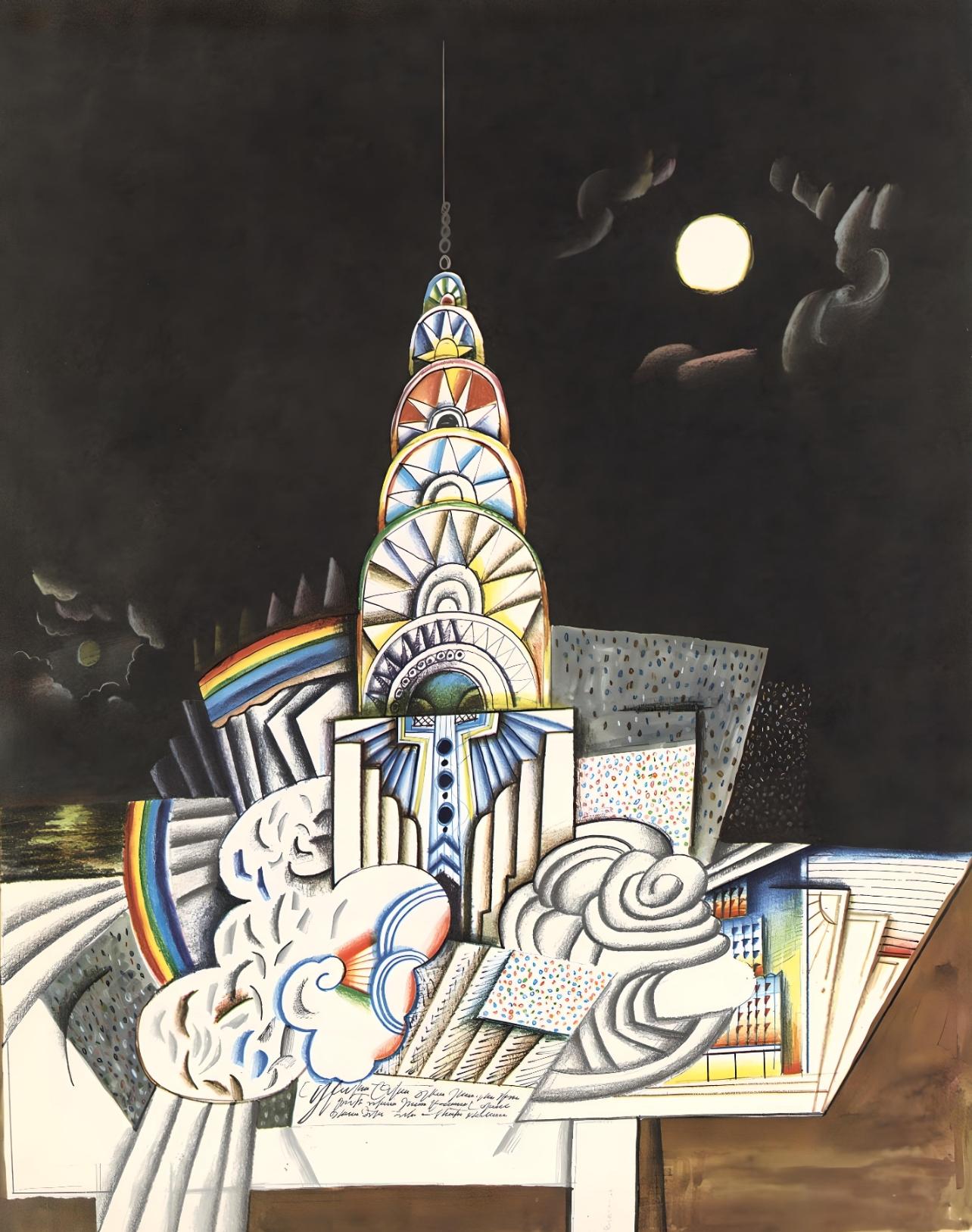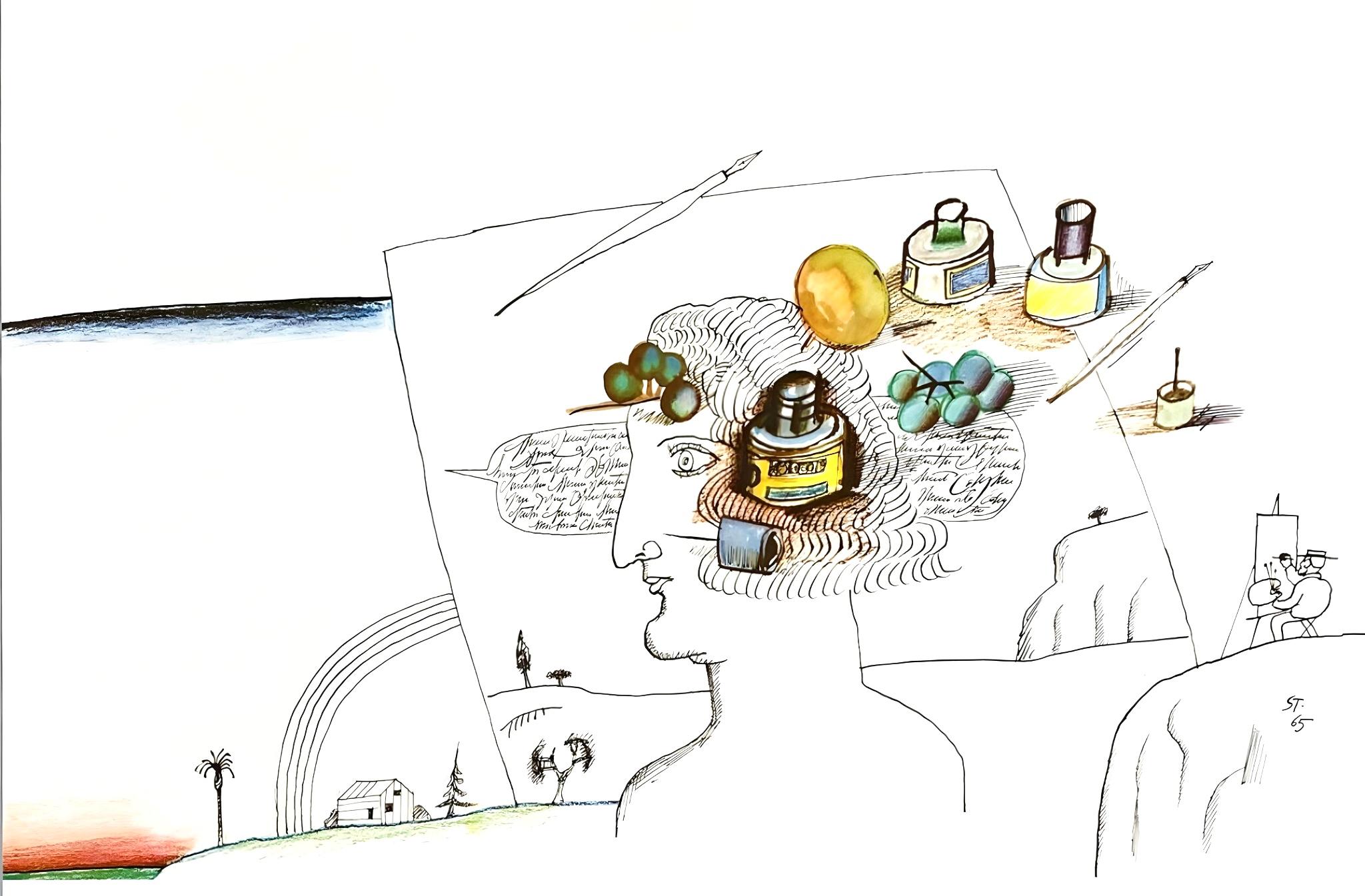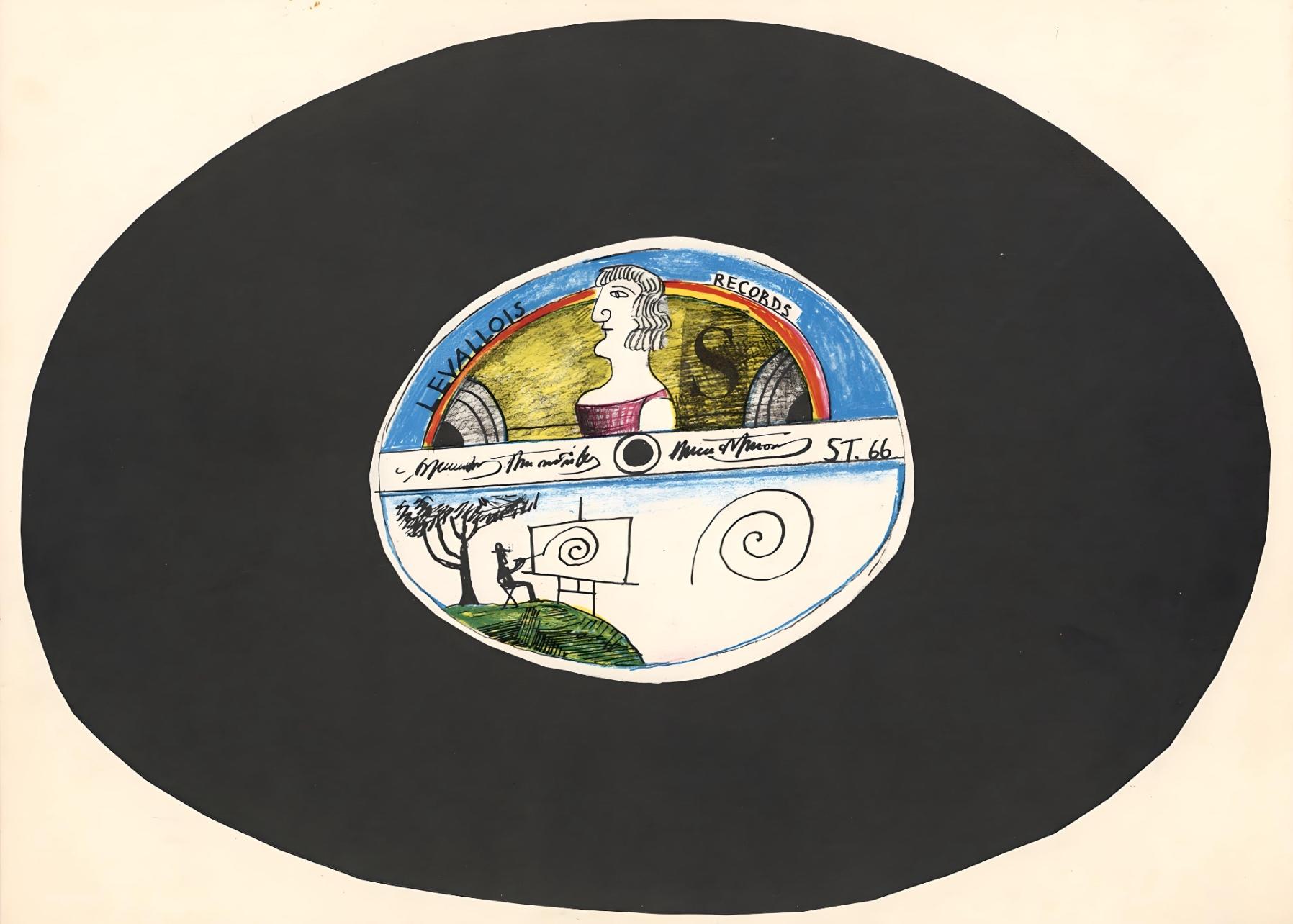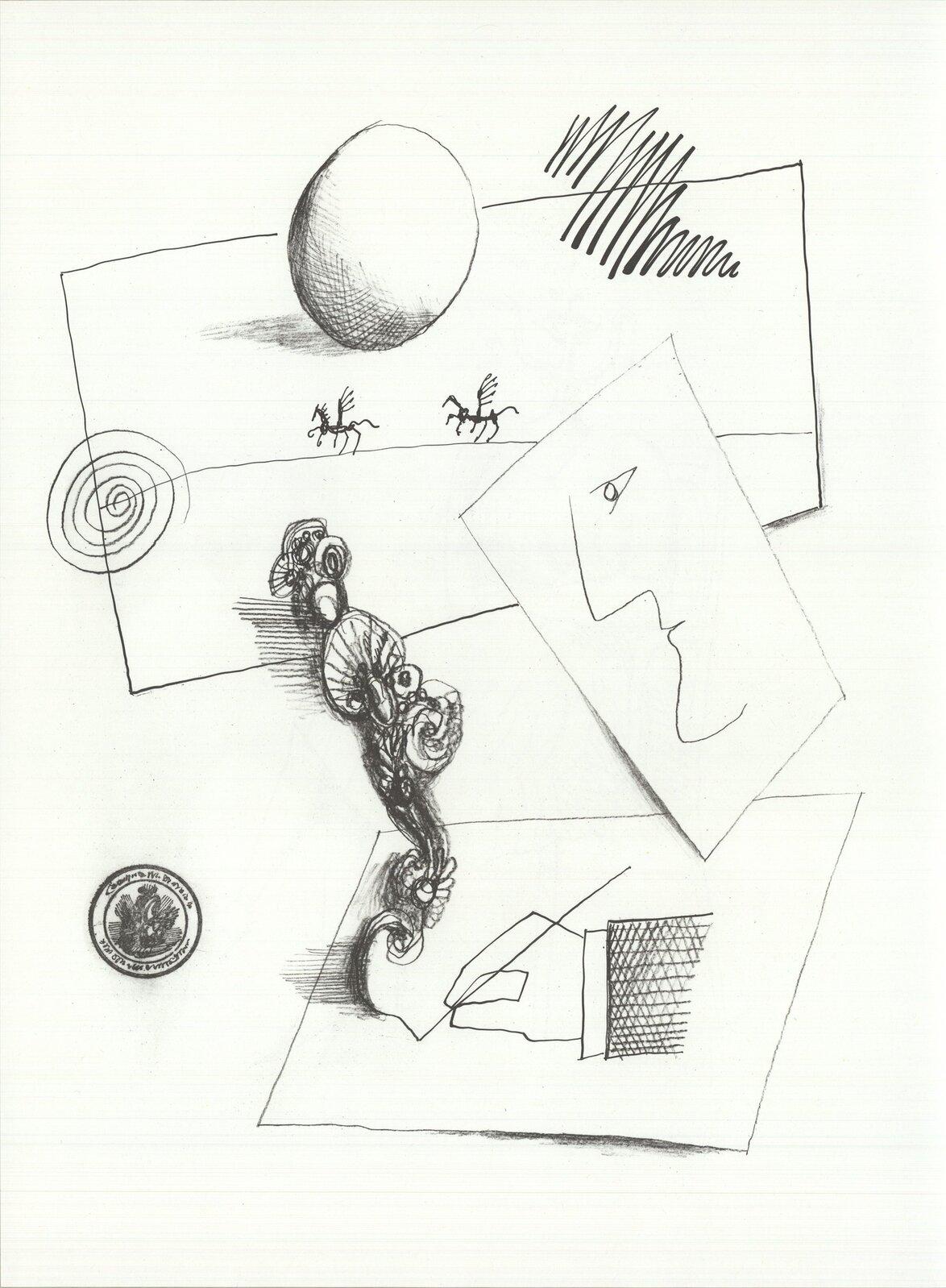Items Similar to Steinberg, Illustration, Derrière le miroir (after)
Want more images or videos?
Request additional images or videos from the seller
Steinberg, Illustration, Derrière le miroir (after)1966
1966
About the Item
Lithograph on wove paper. Inscription: Signed in the plate and unnumbered; text on verso, as issued. Good Condition; with centerfold, as issued. Notes: From Derrière le miroir, N° 157, published by Derrière le miroir, Paris; printed by Galerie Maeght, Paris, 1966. Excerpted from a Christie’s, New York lot essay, The life span of Derrière le Miroir was thirty-five years. Publication began in 1946. Aimé Maeght, initiator of Derrière le Miroir, had already made few attempts to start publications illustrated with fine printed lithographs in colours in the years prior to the launch of Derrière le Miroir. The name, Derrière le Miroir was suggested by Jacques Kober, manager of Galerie Maeght. The gallery had opened in 1945; the first number of Derrière le Miroir was released a year later. For this first issue Geer van Velde was invited to create lithographs to illustrate the publication. The lithographs in the first issue was printed by Mourlot, Paris. The first three issues of Derrière le Miroir were unsuccessful for Maeght as far as the edition size—the initial print-runs were far too large. From 30,000 for the first issue, the number was taken down to 10,000 for numbers two and three, until Derrière le Miroir number four was published in an edition of 1500. Maeght instituted a policy whereby unsold issues were recycled and used for the fabrication of new paper for the coming editions—this served to both conserve resources and also usually result in ultimate edition sizes far less than 1,500. With number four, the permanent format for Derrière le Miroir was established. Lithographs in colours were key; text was limited to comments on the featuring artist's exhibition taking place in the Galerie Maeght, and this catalogue format was defining to Derrière le Miroir. Galerie Maeght took on the leading role in Paris and presented all main artists including Braque, Matisse, Chagall, Léger, Bonnard, Chillida and many more. So too did Derrière le Miroir. The idea of a magazine was meanwhile still on the mind of Aimé Maeght. He found an insert as a solution. Two, and later four, pages of art review were inserted from 1952 onwards. In 1968 this find had ripened to independency and the dream of Aimé Maeght was now a tangible fact named l'Art vivant. Derrière le Miroir was on it's own again. Over 250 issues in a row. At that point publisher Aimé Maeght wished to make a mark with the publication of an hommage to all who once contributed to the magazine which came in the form of issue number 250, but was delayed by the death of Aimé Maeght. It was published after number 253 in 1982 and became a tribute to Aimé and Marguérite Maeght and 35 years of friendship with artists and poets. The era of Derrière le Miroir was closed with that final publication.
SAUL STEINBERG (1914-1999 ) Romanian-American cartoonist and illustrator best known for his iconic contributions to The New Yorker magazine. As synonymous with illustration as Picasso is with cubism, Steinberg’s drawing style is characterized by a playful, childlike-doodle quality while also maintaining an elegant deftness that succinctly described a wide range of subjects. His quirky, sharply observed sketches, at times reminiscent of Dada art, also crossed over into the fine arts world. Saul Steinberg made drawings and sculptures that established him as an acute visual chronicler of the modern American psyche. From the single, unbroken flourishes of his smaller cartoons to the dense detail seen in his New York cityscapes, the lines in Steinberg’s illustrations are famously emotive.
- Creation Year:1966
- Dimensions:Height: 15 in (38.1 cm)Width: 22 in (55.88 cm)
- Medium:
- Movement & Style:
- After:Saul Steinberg (1914-1999, American)
- Period:
- Condition:
- Gallery Location:Auburn Hills, MI
- Reference Number:1stDibs: LU1465213964572
About the Seller
4.9
Gold Seller
These expertly vetted sellers are highly rated and consistently exceed customer expectations.
Established in 2002
1stDibs seller since 2021
865 sales on 1stDibs
Typical response time: <1 hour
- ShippingRetrieving quote...Ships From: Clinton Township, MI
- Return PolicyA return for this item may be initiated within 1 day of delivery.
More From This SellerView All
- Tàpies, Composition, Derrière le miroir (after)By Antoni TàpiesLocated in Auburn Hills, MILithograph on wove paper. Inscription: Unsigned and unnumbered. Good Condition; with centerfold, as issued. Notes: From Derrière le miroir, N° 207, published by Derrière le miroir, P...Category
1970s Post-War Still-life Prints
MaterialsLithograph
- Tàpies, Composition (Galfetti 315), Derrière le miroir (after)By Antoni TàpiesLocated in Auburn Hills, MILithograph on wove paper. Inscription: Unsigned and unnumbered. Good Condition; with centerfold, as issued. Notes: From Derrière le miroir, N° 200, published by Derrière le miroir, P...Category
1970s Post-War Still-life Prints
MaterialsLithograph
- Tàpies, Composition (Galfetti 83-86), Derrière le miroir (after)By Antoni TàpiesLocated in Auburn Hills, MILithograph on wove paper. Inscription: Unsigned and unnumbered. Good Condition; with centerfold, as issued. Notes: From Derrière le miroir, N° 168, published by Derrière le miroir, P...Category
1960s Post-War Still-life Prints
MaterialsLithograph
- Tàpies, Composition, Derrière le miroir (after)By Antoni TàpiesLocated in Auburn Hills, MILithograph on wove paper. Inscription: Unsigned and unnumbered. Excellent Condition; with centerfold, as issued. Notes: From Derrière le miroir, N° 210, published by Derrière le miro...Category
1970s Post-War Still-life Prints
MaterialsLithograph
- Steinberg, Illustration, Derrière le miroir (after)By Saul SteinbergLocated in Auburn Hills, MILithograph on wove paper. Inscription: Unsigned and unnumbered; text on verso, as issued. Good Condition. Notes: From Derrière le miroir, N° 157, published by Derrière le miroir, Par...Category
1960s Post-War Abstract Prints
MaterialsLithograph
- Tàpies, Composition (Galfetti 83-86), Derrière le miroir (after)By Antoni TàpiesLocated in Auburn Hills, MILithograph on wove paper. Inscription: Unsigned and unnumbered. Good Condition; with trifold, as issued. Notes: From Derrière le miroir, N° 168, published by Derrière le miroir, Pari...Category
1960s Post-War Still-life Prints
MaterialsLithograph
You May Also Like
- Vintage Original Poster Sister Corita Kent Lithograph Pop Art "Life Without War"By Mary Corita (Sister Corita) KentLocated in Surfside, FLCorita Kent (American, 1918 - 1986)"We Can Create Life without War" Corita Billboard Peace Project Poster 1985 Corita Billboard Event - Part of Peace Week, January 17-24, 1985 San Lu...Category
1980s Pop Art Abstract Prints
MaterialsLithograph, Screen, Offset
- Le masque à gaz, Gas Mask Hand Signed Lithograph SilkscreenBy ArmanLocated in Surfside, FLLe masque à gaz, 1971, edition of 300. Signed "Arman" in pencil l.r., numbered in pencil l.l. Lithograph in purple and gold on paper, image size 25 3/8 x 19 3/8 in. (64.3 x 49.0 cm),...Category
1970s Abstract Abstract Prints
MaterialsLithograph
- Violent Violin Concerto Hand Signed Lithograph SilkscreenBy ArmanLocated in Surfside, FLArman (November 17, 1928 – October 22, 2005) was a French-born American artist. Born Armand Fernandez in Nice, France, Arman was a painter who moved from using objects for the ink or...Category
1970s Abstract Abstract Prints
MaterialsLithograph
- French Modernist Mourlot Lithograph Vintage Air France Poster Roger BezombesBy Roger BezombesLocated in Surfside, FLVintage French Travel Poster, Air france Roger Bezombes (1913-1994) French Bezombes was a painter, sculptor, medalist, and designer. He studied in Paris, at the École des Beaux-Arts, and was much influenced by his friendship with Maurice Denis. Heavily influenced by surrealism, He worked principally as a painter, adopting the saturated Fauvist colors of Henri Matisse in landscapes and figure studies often based on observation of “exotic” cultures, notably Mediterranean and North African. Constrained, because a very young orphan, to all kinds of professions which provide him with the material means to devote himself to painting - he participated in 1930 in the installation of the exhibition of the Bauhaus at the Grand Palais-, Roger Bezombes is student of the National School of Fine Arts in Paris. (Ecole des Beaux Artes) He was trained in the art of fresco by Paul Baudoüin, René Barotte nonetheless restores that the young man's preference goes to the practice of "truancy" which he uses to make copies at the Louvre Museum. It’s the time when Paul Gauguin’s paintings, Vincent Van Gogh and Henri Matisse are revealed to him by Maurice Denis with whom he will remain close until his accidental death, painting him on his funeral bed on November 14, 1943. He executed surrealist tapestry designs for Aubusson and Gobelin tapestries, posters (winning the Grand Prix de l'Affiche Francaise in 1984), costumes and sets for ballets at the Metropolitan Opera House in New York, reliefs and murals. In 1965 he took up medal-making, expressing in his numerous metallic works for the Paris Mint that obsession with found objects which is also evident in his large-scale sculpture and in his posters. He designed posters for Air France and for the French national railways. Roger Bezombes went to Africa for the first time in 1936 thanks to a travel grant and received the same year the second grand prize of Rome . In 1937 he traveled around Morocco where he became friends with Albert Camus. The year 1938 offered him both his first solo exhibition at the Charpentier gallery in Paris with paintings and gouaches on the theme of Morocco and the attribution of the national grand prize for the arts, earning him a great journey which , from Dakar to Algiers , takes it through Chad , Tamanrasset and Hoggar. Roger Bezombes became a professor at the Julian Academy in 1950. For him, 1951 was the year of a trip to Greece and the year where he began his relationship with tapestry work. Roger Bezombes visited Israel in 1953, Tunisia and Egypt in 1954. He was appointed official painter of the Navy in 1955. Pierre Mazars analyzes that “after a period where we notice the influence of Van Gogh and GeorgesBraque, particularly in his landscapes of Provence, he came to a more schematic writing, the colored spots and the thicknesses of material taking more of importance as the subject. He even performed composite works, half-watercolors, half-pasted papers, in which he incorporated pieces of newspapers”. He was elected titular to the Academy of Overseas Sciences in 1978. "The range of Bezombes' talent forms is remarkable,” writes Lynne Thornton, “ranging from paintings, murals, travel posters, tapestry cartons, book illustrations, monumental ceramic decorations, ballet and theater sets, totem sculptures, sculpture objects, jewelry and medallions”. He was part of the mid century mod School of Paris that included Leon Zack, Bernard Lorjou, Paul Augustin Aizpiri, Gabriel Godard, Michel Henry, Hans Erni, Bengt Lindstrom, Alfred Manessier, Andre Hambourg, Raymond Legueult and Jean Rigaud. Select Solo Exhibitions: 1938: Galerie Charpentier, Paris 1950, '53, '55, '57: Galerie Andre Weil, Paris 1953:Wildenstein Gallery, London 1954: Institut Francais, Cologne 1956: Galerie Matarasso, Nice 1957: Horn Gallery, Luxembourg; Guilde de la Gravure, Paris 1958: Denys-Puech Museum, Rodez 1962: Musee de l'Athenee, Geneva; Chateau Grimaldi, Cagnes-sur-Mer 1966: Galerie des Ponchettes, Nice 1967: Galerie Martel, Montreal 1968: Romanet-Vercel Gallery, New York; Reattu Museum, Arles; Le Corbusier Center, Firminy 1969: Galerie Philippe...Category
1980s Modern Abstract Prints
MaterialsLithograph
- Set of Eyes, Color Lithograph, Belgian Abstract Expressionist Tamarind PrintBy Dirk de BruyckerLocated in Surfside, FLSigned, dated and titled. Initialed and dated lower right, each numbered 8/20, lower left. 9 x 6 image size, 22 x 15 in. sheet size. With the blindstamp of the Tamarind Institute print...Category
1990s Abstract Expressionist Abstract Prints
MaterialsLithograph, Archival Paper
- 1940's Abstract Composition Jazz Lithograph Pencil Signed and Dated WPA ArtistBy Konrad CramerLocated in Surfside, FLKonrad Cramer, 1888-1963 was a painter, photographer, printer, and illustrator. Based in the fertile Woodstock, New York, artistic community along with Yasuo Kuniyoshi and Russell Lee, Cramer was both educator and artist. He ran a summer school for miniature camera photography in the 1930s and later taught one of the first American college courses in photography at Bard College. Although he began as a painter of abstract, geometric forms in bold colors, Cramer is most known as a photographer. Konrad Cramer was born and raised in Wurzburg, Germany. Cramer studied to be an artist at the Karlsruhe Academy under Ludwig Schmidt-Reutte and Ernest Schurth. He became interested in the German avant-garde early in his schooling, he was a member of the Blaue Reiter, exposed and encouraged by the experimental works of Wassily Kandinsky and Franz Marc. An additional influence on Cramer's artistic development was the Cubist landscapes of Paul Cézanne. Florence Ballin Cramer opened a gallery on 57th Street in 1919, encouraged by the sculptor Elie Nadelman. Florence Gallery exhibited and sold the works of living artists. Although it only survived briefly, it was the first New York gallery to show works by Yasuo Kuniyoshi, Alexander Brook, Ernest Fiene, and Stefan Hirsch. Cramer then settled with his wife in Woodstock, New York, where Ballin had painted with the Art Students League each summer since 1906. Cramer established a reputation as one of Woodstock's most modern painters with an impressive series of abstract paintings exhibited at the MacDowell Club in 1913. In the 1920s Cramer developed a personal representational style which blended modern and regional influences. Cramer received a Rockefeller grant in 1920 to study educational methods for craftsmen in Germany and France. In 1922 he took a teaching position at the Woodstock School of Painting and helped establish the Woodstock Artists Association, where he served as a director. While teaching and painting, Cramer also applied his artistic talent to illustration and textile design. Konrad Cramer first exhibited at the Whitney Studio Club in 1924 and participated in the Whitney Museum of American Art's first and second biennials in 1933 and 1935. He was also included in the 1935 exhibition Abstract Painting in America at the Whitney. Cramer was later included in the Whitney Museum exhibition Pioneers of Modern Art in America in 1946. In the 1930s Cramer participated in many other museum invitationals, including: the Carnegie International (1929, 1933, 1937, 1938); the Pennsylvania Academy of the Fine Arts (1934, 1936), and the Corcoran Gallery of Art (1935, 1937). In 1934 Konrad Cramer and his wife travelled to Mexico where they produced many paintings and drawings. Back in Woodstock in 1935, Cramer briefly joined the (WPA) Federal Art Project, administering the regional program in Woodstock. In the mid-1930s Cramer took up photography to clarify aesthetic issues in his painting. Cramer had gotten to know Alfred Stieglitz upon his arrival in America in 1911 and wrote an essay about 291 Gallery for Stieglitz's magazine Camera Work in 1914. Through Stieglitz and then in the 1930s fellow Woodstockers like Russell Lee, Cramer became interested in the possibilities of photography and began working with it as an artistic medium. In the 1950s Cramer collaborated on a traveling exhibition and book of abstract photographs with Manuel Komroff...Category
1940s Abstract Abstract Prints
MaterialsLithograph





